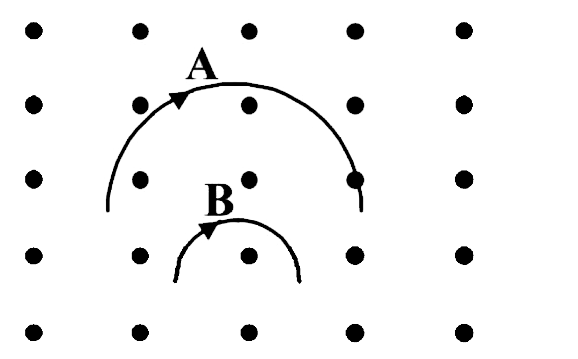A diatomic molecule two identicla atoms of mass m bound together a distance l apart is confined in a lab reference frame. At a certain time one of the two atoms is observed to have speed v0 and the other, moving in the opposite direction, speed v0/3.

Step by step video & image solution for A diatomic molecule two identicla atoms of mass m bound together a distance l apart is confined in a lab reference frame. At a certain time one of the two atoms is observed to have speed v_(0) and the other, moving in the opposite direction, speed v_(0)//3. by Physics experts to help you in doubts & scoring excellent marks in Class 11 exams.
Topper's Solved these Questions
- BOOK - ANURAG MISHRACHAPTER - RIGID BODY MOTIONEXERCISE - SCQ_TYPE83videos
RIGID BODY MOTION
- BOOK - ANURAG MISHRACHAPTER - RIGID BODY MOTIONEXERCISE - MCQ_TYPE41videos
RIGID BODY MOTION
- BOOK - ANURAG MISHRACHAPTER - IMPULSE AND MOMENTUMEXERCISE - matching3videos
IMPULSE AND MOMENTUM
- BOOK - ANURAG MISHRACHAPTER - UNIT AND DIMENSIONSEXERCISE - Matching Type Problem4videos
UNIT AND DIMENSIONS
Similar Questions
Relative speed of two persons moving with u m/s and v m/s in opposite direction where u>v
View SolutionA block of 10kg mass is thrown on a rough surface having friction coefficient 0.3 with an initial speed of 5 m/s. Find the amount by which the internal energy of the blocked and the surface will increase. If this block is seen from a frame moving at a speed of 5 m/s in the direction of its velocity it is observed that the block is gently put on the rough surface moving in opposite direction at speed 5 m/s. Find the gain kinetic energy of the block as seen from this frame.
View Solution
Knowledge Check
- Question 1 - Select One
Two events occur simultaneously on the x axis of reference frame S, one at x = 0 and the other at x = +1. According to an observer moving in the positive x direction
AThe event at x = +1 occurs firstBThe event at x = 0 occurs firstCEither event might occur first, depending on the value of (a) and the observer's speedDThe events are simultaneous - Question 2 - Select One
Two particles AandB of masses mAandmB respectively and having the same charge are moving in a plane . The speeds of the particles are vAandvB respectively and the trajectories are as shown in the figure. Then
 AmAvA<mBvBBmAvA>mBvBCmAvA<mBandvA<vBDmA=mBandva=vB
AmAvA<mBvBBmAvA>mBvBCmAvA<mBandvA<vBDmA=mBandva=vB - Question 3 - Select One
Two canoes are 10 m apart on a lake. Each bobs up and down with a period of 4.0 s. when one canoe is at its highest point, the other canoe is at its lowest point. Both canoes are always within a single cycle of the waves determine the speed of the wave.
A2.5m/sB5m/sC40m/sD4m/s
A diatomic molecule moving at a speed u absorbs a photon of wavelenght λ and then dissociates into two identical atoms. One of the atoms is found to be moving with a speed v in a direction perpendicualr to the initial direction of motion of the molecule. Take mass of the molecule to be M and calculate the binding energy of the molecule. Assume that momentum of absorbed photon is negligible compared to that of the molecule.
View SolutionA circle of radius unity is centered at thet origin. Two particles tart moving at the same time from the point (1,0) and move around the circle in opposite direction. One of the particle moves anticlockwise with constant speed v and the other moves clockwise with constant speed 3v. After leaving (1,0), the two particles meet first at a point P, and continue until they meet next at point Q. The coordinates of the point Q are
View SolutionA and B are two points 150 km apart on a highway. Two cars start with different speeds from A and B at same time. If they move in same direction, they meet in 15 hours. If they move in opposite direction, they meet in one hour. Find their speeds
View SolutionA particle moves in a straight line from A to B
(a) for the first half of distance with speed v1 and the next half of distance with speed v2.
(b) for the first one-third distance with speed v1 and the next two-third distance with speed v2.
(c ) for the first one-fourth distance with speed v0, the next half of distance with speed 2v0 and the last one-fourth distance with speed 3v0.
Find the average speed in each case.View SolutionTwo unstable particles move in the reference frame K along a straight line in the same direction with a velocity v=0.990c. The distance between them in this reference frame is equal to l=120m. At a certain moment both particles decay simultaneously in the reference frame fixed to them. What time interval between the moments of decay of the two particles will be observed in the frame K? Which particle decays later in the frame K?
View Solution

